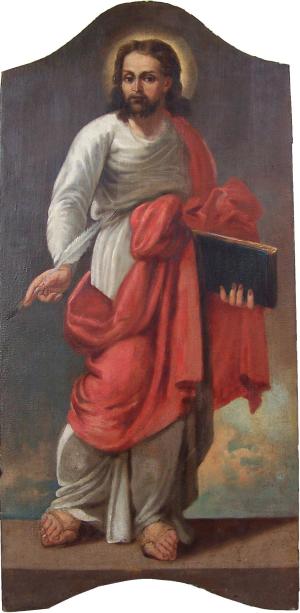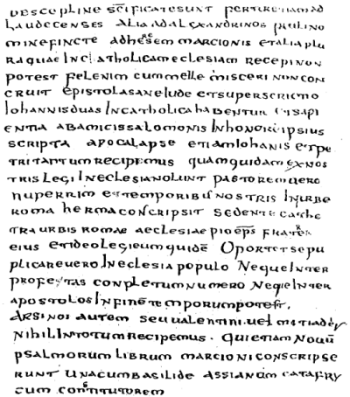is the new testament reliable?
B. Who was Mark and did he write the Gospel of Mark?

As with the Gospel of Matthew, there was no title at the beginning of the original writing of this account identifying the authorship. The title was placed in the front of these writings in the middle of the second century by the early church based on their tradition and understanding that named Mark as the author. This narrative, in this sense, was written anonymously. All of the books in the New Testament except Hebrews and I–III John, begin by identifying the writer. However, none of the Gospels or the book of Acts begin with the authors identifying themselves. For whatever reason, they did not wish to insert themselves into the picture that they were painting.
They may have wanted the portrait of the painting, the hero of the narrative, to be Jesus Christ. It is interesting to note that many of the numerous Gnostic “gospels” and narratives regarding Christ that the church rejected, attributed their authorship to an important apostle or New Testament personality – Peter, Philip, Judas, Andrew, Mary, Thomas, Nicodemus… This was done to attempt to validate the claim of authoritative authorship. But this was not so with the four Gospels and yet the early church recognized the authority of these writings even though written anonymously.
The 2nd century Church knew who wrote them and titles were not necessary because they knew where they had come from. Titles were later placed at the beginning of these narratives, as noted earlier, in order to identify and classify these books so that as these Gospel narratives were copied and circulated among the churches, the individual congregations would know who the particular author and source was. This is the case with Mark’s Gospel. So who was Mark and did he write this Gospel? The following is a listing of early church fathers who stated that Mark was indeed the author of the Gospel of Mark:
Papias: (60-130 A.D.)
Eusebius, the 3rd century church historian has preserved some of the writings of Papias, the bishop of Heirapolis, who died in A.D. 120-130. He was a student of the “elder”, the apostle John. Papias stated:“The Elder used to say this also: Mark having been the interpreter of Peter, wrote down accurately all that he (Peter) mentioned, whether sayings or doings of Christ, not, however in order. For he was neither a hearer nor a companion of the Lord; but afterwards, as I said, he accompanied Peter, who adapted his teachings as necessity required, not as though he were making a compilation of the sayings of the Lord. So then Mark made no mistake writing down in this way some of the things as he (Peter) mentioned them; for he paid attention to this one thing, not to omit anything that he had heard, not to include any false statement among them.” – Eusebius, Church History, III. 39
Early church father quotes and writings are found in numerous sources. The books History of the Christian Church – Philip Schaff and the Church History – Eusebius; are two excellent sources.This information, from an individual who accompanied the apostle John, gives solid historical evidence that Mark (from the apostle Peter as the source) wrote the Gospel of Mark.(There are many early church father quotations and writings as noted here, that are found in numerous sources. The books History of the Christian Church – Philip Schaff and the Church History – Eusebius; are two excellent sources.)
Justin Martyr: (100-165 A.D.)
“It is said that he [Jesus] changed the name of one of the apostles to Peter; and it is written in his memoirs that he changed the names of others, two brothers, the sons of Zebedee, to Boanerges, which means ‘sons of thunder’….” – Dialogue with TryphoJustin Martyr states that this particular Gospel is the “memoir”of Peter and said this “memoir” described the sons of Zebedee as the “sons of thunder”. It is only in Mark’s Gospel that this description of James and John is provided for in this manner, so it is safe to assume that the Gospel of Mark is the memoir of Peter that he is referring to. (Mark 3:16,17)
Clement: (150-215)
Clement of Alexandria authored a book entitled Outlines book 6, and it is included in Eusebius’s Ecclesiastical History 2: 15. In this work, Clement states-“And so great a joy of light shone upon the minds of the hearers of Peter that they were not satisfied with merely a single hearing or with the unwritten teaching of the divine gospel, but with all sorts of entreaties they besought Mark, who was a follower of Peter and whose gospel is extant, to leave behind with them in writing a record of the teaching passed on to them orally; and they did not cease until they had prevailed upon the man and so became responsible for the Scripture for reading in the churches.”
Eusebius also provides additional information in Ecclesiastical History 6: 14 relating Mark with Peter:“The Gospel according to Mark had this occasion. As Peter had preached the Word publicly at Rome, and declared the Gospel by the Spirit, many who were present requested that Mark, who had followed him for a long time and remembered his sayings, should write them out. And having composed the Gospel he gave it to those who had requested it. When Peter learned of this, he neither directly forbade nor encouraged it.”
The way that this narrative is framed indicates that Clement was not just passing down information that he had heard from Papias, but that the additional information probably came from some other line of information thus providing more than one tradition regarding Mark’s authorship of this Gospel. Eusebius provides this quote in Outlines, book 6 – Ecclesiastical History 6:15.
Irenaeus: (A.D. 125-202)
Irenaeus, the Bishop of Lyons, was a student of Polycarp, (who like Papias was a student of the apostle John). Irenaeus wrote:“Matthew published his Gospel among the Hebrews in their own tongue, when Peter and Paul were preaching the gospel in Rome and founding the church there. After their departure (death), Mark, the disciple and interpreter of Peter, himself handed down to us in writing the substance of Peter’s preaching . Luke, the follower of Paul, set down in a book the gospel preached by his teacher. Then John, the disciple of the Lord, who also leaned on His breast (John 13:25; 21:20) himself produced his Gospel while he was living in Ephesus.” – Irenaeus, Against Heresies
Tertullian: (160-225A.D.)
Second century Christian theologian and apologist, Tertullian, wrote a book that refuted the theology and teaching of Marcion. The narrative was entitled, “Against Marcion” and in book 4 chapter 5, he stated the following regarding the Gospel of Mark:“While that (Gospel) which Mark published may be affirmed to be Peter’s whose interpreter Mark…”
 |
The Muratorian Fragment: (170 A.D.)
The Muratorian Fragment is the oldest known list of New Testament books. The first line reads as follows: “But he was present among them, and so he put [the facts down in his Gospel]”
This was probably a reference to the fact that Mark was with Peter and that he heard and recorded Peter’s Gospel.
Origen: (185-253 A.D.)
Eusebius in his work Ecclesiastical History Book 6 Chapter 25 quotes a Gospel commentary that was written by Origen that provides information on the sources of all four Gospels. He clearly states that the Gospel of Mark was written by Mark and that he recorded Peter’s narratives of the Gospel.
“In his first book on Matthew’s Gospel, maintaining the Canon of the Church, he testifies that he knows only four Gospels, writing as follows: Among the four Gospels, which are the only indisputable ones in the Church of God under heaven, I have learned by tradition that the first was written by Matthew, who was once a publican, but afterwards an apostle of Jesus Christ, and it was prepared for the converts from Judaism, and published in the Hebrew language. The second is by Mark, who composed it according to the instructions of Peter, who in his Catholic epistle acknowledges him as a son, saying, ‘The church that is at Babylon elected together with you, salutes you, and so does Marcus, my son.’ I Peter 5:13 And the third by Luke, the Gospel commended by Paul, and composed for Gentile converts. Last of all that by John.”
This evidence of the early second and third century church sources identifies Mark as the author of the Gospel of Mark. Who was Mark? In the New Testament, he is referred to as John Mark – Acts 12:25. He was a cousin of Paul’s associate, Barnabas – Colossians 4:10 and he was a companion of Peter – I Peter 5:13 to whom the apostle referred as “Mark, my son”.
We know that he accompanied Paul and Barnabas on Paul’s first missionary journey but left them on the way to Perga. Later, when Barnabas wanted Paul to bring Mark along on a second missionary trip, Paul refused and this led to a separation between Barnabas and Paul. However, Mark later became a valuable resource for the apostle Paul and is listed as a “fellow worker” in the Gospel – Philemon 24, and as “useful to me for ministry” – II Timothy 4:11.
The literary style with which he wrote this Gospel indicates that he had a moderate education and the koine Greek linguistic syntax and word usage he employed would be that of someone who probably did not have Greek as a first language. What we know of him probably indicates that his primary language was Aramaic.